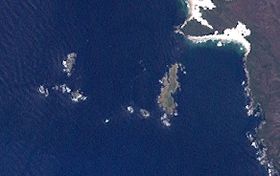 A
Landsat image of the Mutton Bird Islands Group. | |
Location off the
south western coast of
Tasmania | |
| Geography | |
|---|---|
| Location | South western Tasmania |
| Coordinates | 43°25′12″S 145°55′48″E / 43.42000°S 145.93000°E |
| Archipelago | Mutton Bird Islands Group |
| Adjacent to | Southern Ocean |
| Area | 3.56 ha (8.8 acres) [1] |
| Administration | |
Australia | |
| State | Tasmania |
| Region | South West |
| Demographics | |
| Population | Unpopulated |
Sugarloaf Rock is a steep, rocky unpopulated islet located close to the south-western coast of Tasmania, Australia. Situated some 2 kilometres (1.2 mi) south of where the mouth of Port Davey meets the Southern Ocean, the 3.56-hectare (8.8-acre) islet is one of the eight islands that comprise the Mutton Bird Islands Group. Sugarloaf Rock is part of the Southwest National Park and the Tasmanian Wilderness World Heritage Site. [1] [2]
Fauna
The island is part of the Port Davey Islands Important Bird Area, so identified by BirdLife International because of its importance for breeding seabirds. [3] Recorded breeding seabird and wader species are the short-tailed shearwater (15,000 pairs), fairy prion (2000 pairs), silver gull and sooty oystercatcher. It is a haul-out site for Australian fur seals. [2]
See also
References
- ^ a b "Small Southern Islands Conservation Management Statement 2002" (PDF). Tasmania Parks and Wildlife Service. 2002. p. 30. Archived from the original (PDF) on 22 August 2006. Retrieved 20 July 2006.
- ^ a b Brothers, Nigel; Pemberton, David; Pryor, Helen; Halley, Vanessa (2001). Tasmania's Offshore Islands: seabirds and other natural features. Hobart: Tasmanian Museum and Art Gallery. ISBN 978-0-7246-4816-0.
- ^ "IBA: Port Davey Islands". Birdata. Birds Australia. Retrieved 19 September 2011.
 A
Landsat image of the Mutton Bird Islands Group. | |
Location off the
south western coast of
Tasmania | |
| Geography | |
|---|---|
| Location | South western Tasmania |
| Coordinates | 43°25′12″S 145°55′48″E / 43.42000°S 145.93000°E |
| Archipelago | Mutton Bird Islands Group |
| Adjacent to | Southern Ocean |
| Area | 3.56 ha (8.8 acres) [1] |
| Administration | |
Australia | |
| State | Tasmania |
| Region | South West |
| Demographics | |
| Population | Unpopulated |
Sugarloaf Rock is a steep, rocky unpopulated islet located close to the south-western coast of Tasmania, Australia. Situated some 2 kilometres (1.2 mi) south of where the mouth of Port Davey meets the Southern Ocean, the 3.56-hectare (8.8-acre) islet is one of the eight islands that comprise the Mutton Bird Islands Group. Sugarloaf Rock is part of the Southwest National Park and the Tasmanian Wilderness World Heritage Site. [1] [2]
Fauna
The island is part of the Port Davey Islands Important Bird Area, so identified by BirdLife International because of its importance for breeding seabirds. [3] Recorded breeding seabird and wader species are the short-tailed shearwater (15,000 pairs), fairy prion (2000 pairs), silver gull and sooty oystercatcher. It is a haul-out site for Australian fur seals. [2]
See also
References
- ^ a b "Small Southern Islands Conservation Management Statement 2002" (PDF). Tasmania Parks and Wildlife Service. 2002. p. 30. Archived from the original (PDF) on 22 August 2006. Retrieved 20 July 2006.
- ^ a b Brothers, Nigel; Pemberton, David; Pryor, Helen; Halley, Vanessa (2001). Tasmania's Offshore Islands: seabirds and other natural features. Hobart: Tasmanian Museum and Art Gallery. ISBN 978-0-7246-4816-0.
- ^ "IBA: Port Davey Islands". Birdata. Birds Australia. Retrieved 19 September 2011.
